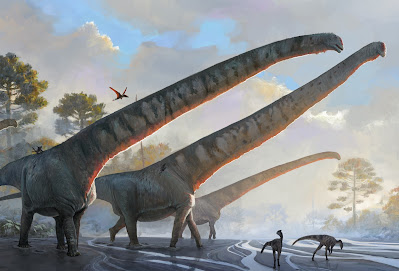 |
| Mamenchisaurus sinocanadorum Russell and Zheng, 1993, in Moore, Barrett, Upchurch, Liao, Ye, Hao & Xu, 2023. Artwork: Júlia d'Oliveira twitter.com/tupandactylus |
Abstract
The sauropod genus Mamenchisaurus, from the Late Jurassic–Early Cretaceous of East Asia, has a convoluted taxonomic history. Although included in the first cladistic analysis of sauropods, only recently has the monophyly of Mamenchisaurus, and the anatomical diversity of the many penecontemporaneous East Asian eusauropods, been evaluated critically. Here, we re-describe the holotype and only specimen of M. sinocanadorum. Although the original diagnosis is no longer adequate, we identify several autapomorphies that support the validity of this species, including an elongate external mandibular fenestra and distinctive pneumatic structures on the cervical centra. We incorporate new data into a phylogenetic character matrix that also includes Bellusaurus and Daanosaurus, both of which are known only from juvenile material and are often hypothesized to be neosauropods (or close relatives thereof). We recover all species of Mamenchisaurus as part of a radiation of predominantly Middle–Late Jurassic East Asian eusauropods, but the genus is non-monophyletic, underscoring the need for further systematic revision of mamenchisaurid taxonomy. Analyses that score ontogenetically variable characters ambiguously recover Bellusaurus and Daanosaurus as juvenile mamenchisaurids, a hypothesis supported by several features that are unique to mamenchisaurids or exhibit little homoplasy, including anteriorly bifurcate cervical ribs. Finally, computed-tomography reveals extensive vertebral pneumaticity in M. sinocanadorum that is comparable to that of the largest sauropods, and updated scaling analyses imply a neck over 14 m long, rivalling estimates for other exceptionally long-necked sauropods. Previous work has suggested that the elongated cervical ribs of particularly long-necked sauropods such as M. sinocanadorum stabilized the neck by limiting its mobility. Given that extent of pneumaticity responds dynamically to a bone’s habitual loading, we propose that long cervical ribs – and other structural modifications that limited flexibility – promoted the evolution of increasingly long necks by producing a more predictable biomechanical milieu amenable to increased pneumatization.
Keywords: sauropod, Mamenchisaurus, pneumaticity, juvenile, neck, vertebrae
Andrew J. Moore, Paul M. Barrett, Paul Upchurch, Chun-Chi Liao, Yong Ye, Baoqiao Hao and Xing Xu. 2023. Re-assessment of the Late Jurassic eusauropod Mamenchisaurus sinocanadorum Russell and Zheng, 1993, and the Evolution of Exceptionally Long Necks in mamenchisaurids. Journal of Systematic Palaeontology. 21(1); 2171818. DOI: 10.1080/14772019.2023.2171818
https://phys.org/news/2023-03-longest-necked-dinosaur-china.html

